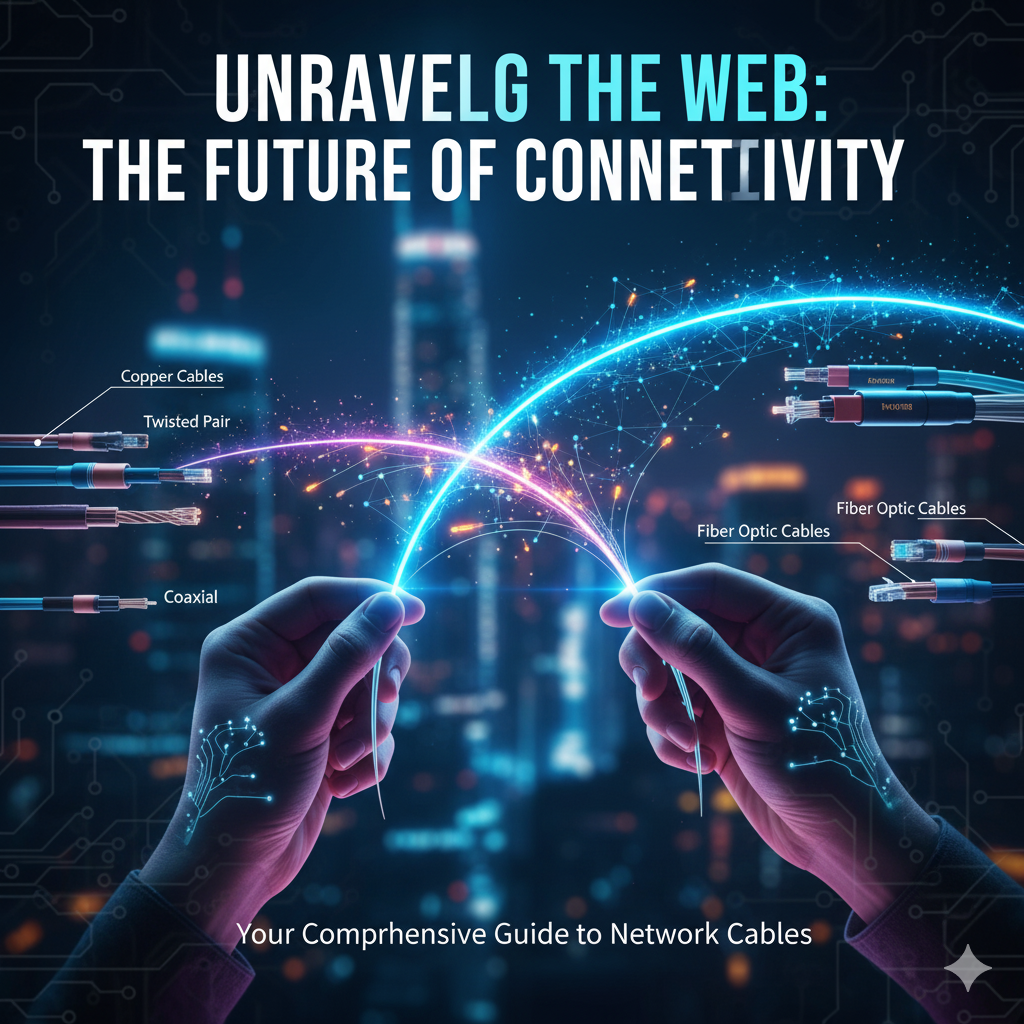
In our increasingly interconnected world, where information flows at the speed of light, it’s easy to take the underlying infrastructure for granted.
We stream, we game, we work, all powered by an invisible network of cables that tirelessly transmit data across vast distances.
But have you ever stopped to consider what these cables are, how they work, and why some are better suited for certain tasks than others?
Today, I want to pull back the curtain and shine a light on the unsung heroes of our digital age: network cables and fiber optics.
From the moment you click a link to the instant a video loads, data is traveling through a complex system of wires and light. Understanding these different mediums isn’t just for IT professionals; it’s for anyone curious about the technology that underpins our modern existence.
Let’s embark on an exploration of the various types of network cables, delve into the marvels of fiber optics, compare their strengths and weaknesses, and finally, cast our gaze towards the exciting possibilities that lie ahead in the realm of data transmission.
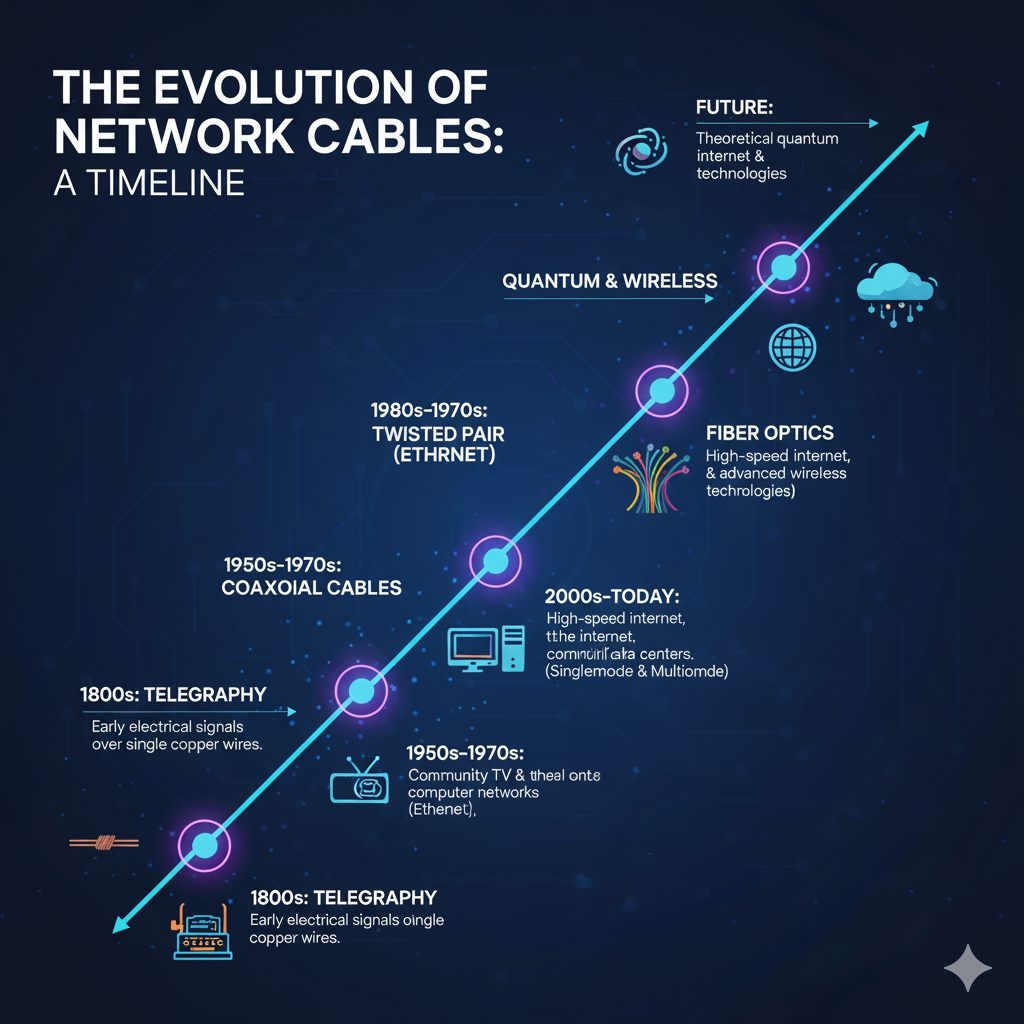
Traditional Network Cables: The Copper Backbone
Before fiber optics became the gold standard for high-speed data, copper-based cables were, and in many cases still are, the workhorses of local area networks (LANs).
These cables rely on electrical signals to transmit data, and their design has evolved significantly over the years to meet increasing demands for speed and reliability. Let’s look at the most common types.
Twisted Pair Cables: The Everyday Connectors
Twisted pair cables are arguably the most ubiquitous type of network cable, found in homes and offices worldwide.
Their design is simple yet effective: pairs of insulated copper wires are twisted together.
This twisting helps to reduce electromagnetic interference (EMI) from external sources and crosstalk between adjacent wire pairs, which can degrade signal quality. There are two main categories of twisted pair cables:
Unshielded Twisted Pair (UTP): This is the most common type, widely used for Ethernet networks. UTP cables are flexible and relatively inexpensive, making them a popular choice for general networking needs. They come in various
categories, each with different performance characteristics:
Category 5e (Cat5e): An enhanced version of the older Cat5 standard, Cat5e supports speeds up to 1 Gigabit per second (Gbps) and is suitable for most home and small office networks.
Category 6 (Cat6): Offering higher performance than Cat5e, Cat6 cables can handle speeds up to 10 Gbps over shorter distances (up to 55 meters). They have more stringent specifications for crosstalk and system noise.
Category 6a (Cat6a): The “a” stands for “augmented,” and these cables are designed to support 10 Gbps over longer distances (up to 100 meters). They often feature better shielding to further reduce interference.
Category 7 (Cat7) and Category 8 (Cat8) These are even higher-performance cables, with Cat7 supporting 10 Gbps and Cat8 reaching up to 40 Gbps.
They are typically used in data centers and other high-demand environments.
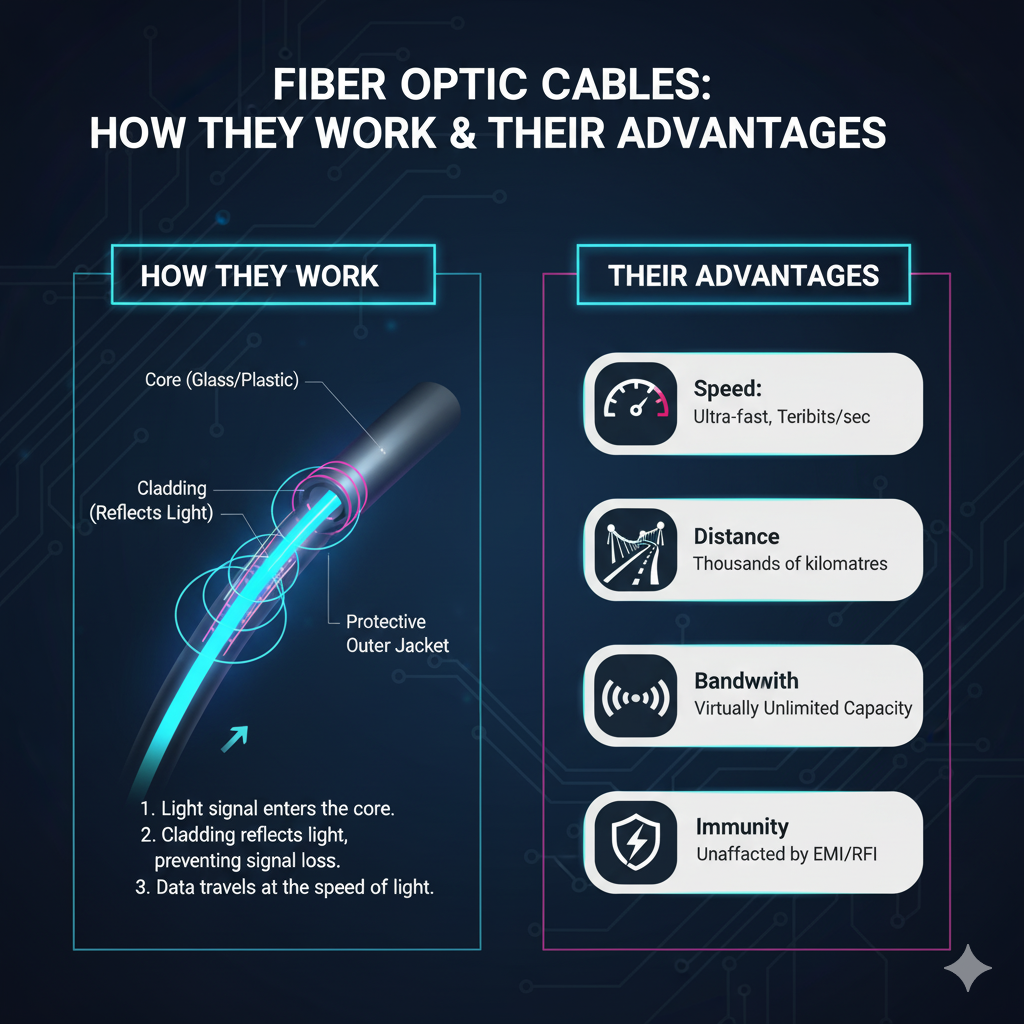
Shielded Twisted Pair (STP): As the name suggests, STP cables include an additional layer of shielding, usually a foil wrap or a copper braid, around the twisted pairs.
This shielding provides extra protection against EMI and is beneficial in environments with high levels of electrical noise, such as factories or areas with powerful motors.
Coaxial Cables: The Predecessor to Twisted Pair
Before twisted pair cables became the standard for Ethernet, coaxial cables were a common sight. You might recognize them as the cables used for cable television (CATV).
A coaxial cable consists of a central copper conductor, surrounded by a layer of insulation, a metallic shield, and an outer insulating jacket. This design makes them more resistant to interference than UTP cables.
While less common for LANs today, they are still used in some applications, particularly for high-frequency signal transmission.
The Dawn of a New Era: Fiber Optic Technology
While copper cables have served us well, they have inherent limitations, particularly when it comes to speed and distance.
This is where fiber optic technology comes in, revolutionizing the way we transmit data.
Instead of electrical signals, fiber optic cables use pulses of light to carry information.
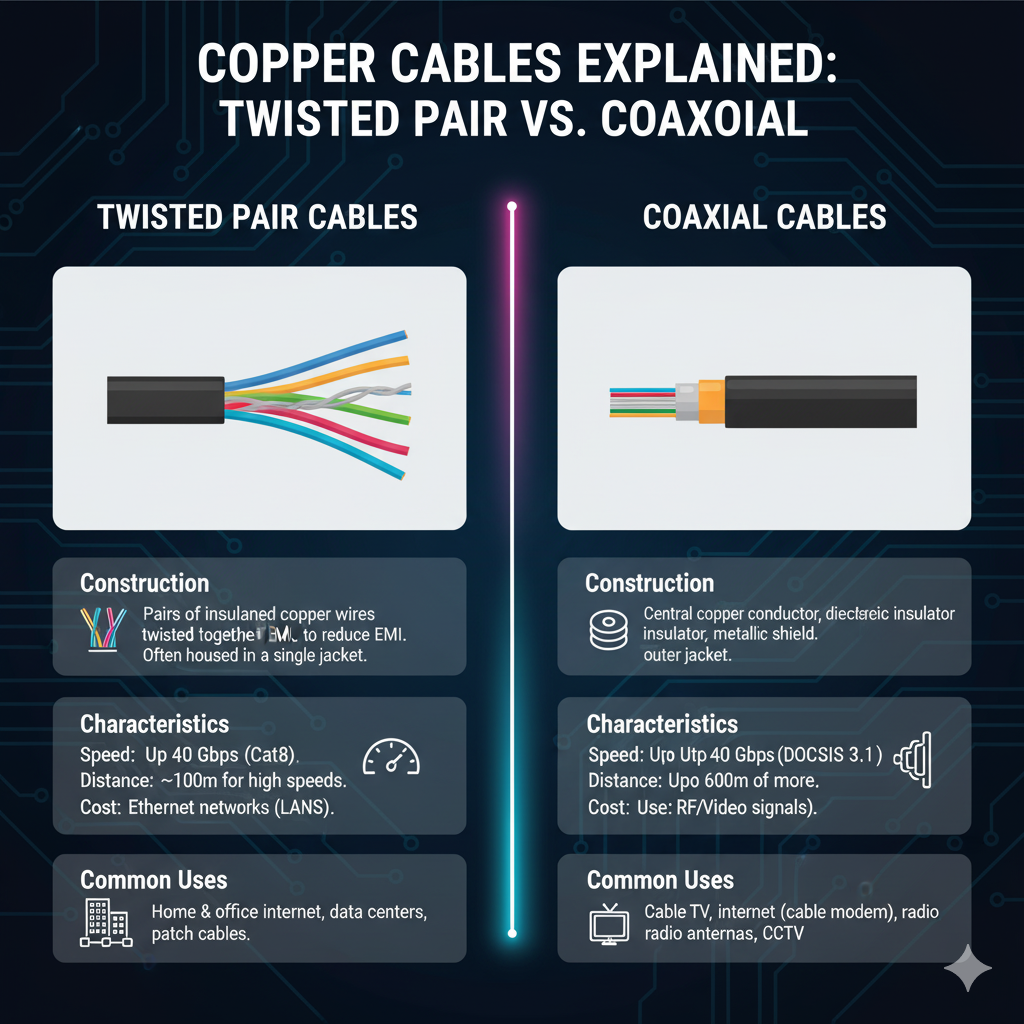
At the heart of a fiber optic cable is a core made of extremely pure glass or plastic, thinner than a human hair.
This core is surrounded by a layer of cladding, which has a lower refractive index than the core.
This difference in refractive indices causes light to be reflected back into the core as it travels down the cable, a phenomenon known as total internal reflection.
This allows light signals to travel over vast distances with minimal loss of signal strength.
There are two main types of fiber optic cables:
Single-Mode Fiber (SMF): SMF has a very narrow core, allowing only a single ray of light to propagate.
This minimizes signal distortion and allows for higher bandwidth and longer transmission distances.
SMF is the backbone of the internet, used for long-haul and transoceanic communication.
Multi-Mode Fiber (MMF): MMF has a larger core that allows multiple rays of light to travel simultaneously.
This makes it less expensive to manufacture and deploy, but it also leads to more signal dispersion, limiting its effective distance.
MMF is typically used for shorter-distance applications, such as within a building or a campus.
Copper vs. Fiber: A Tale of Two Technologies
Now that we have a basic understanding of both copper and fiber optic cables, let’s compare them across a few key metrics:
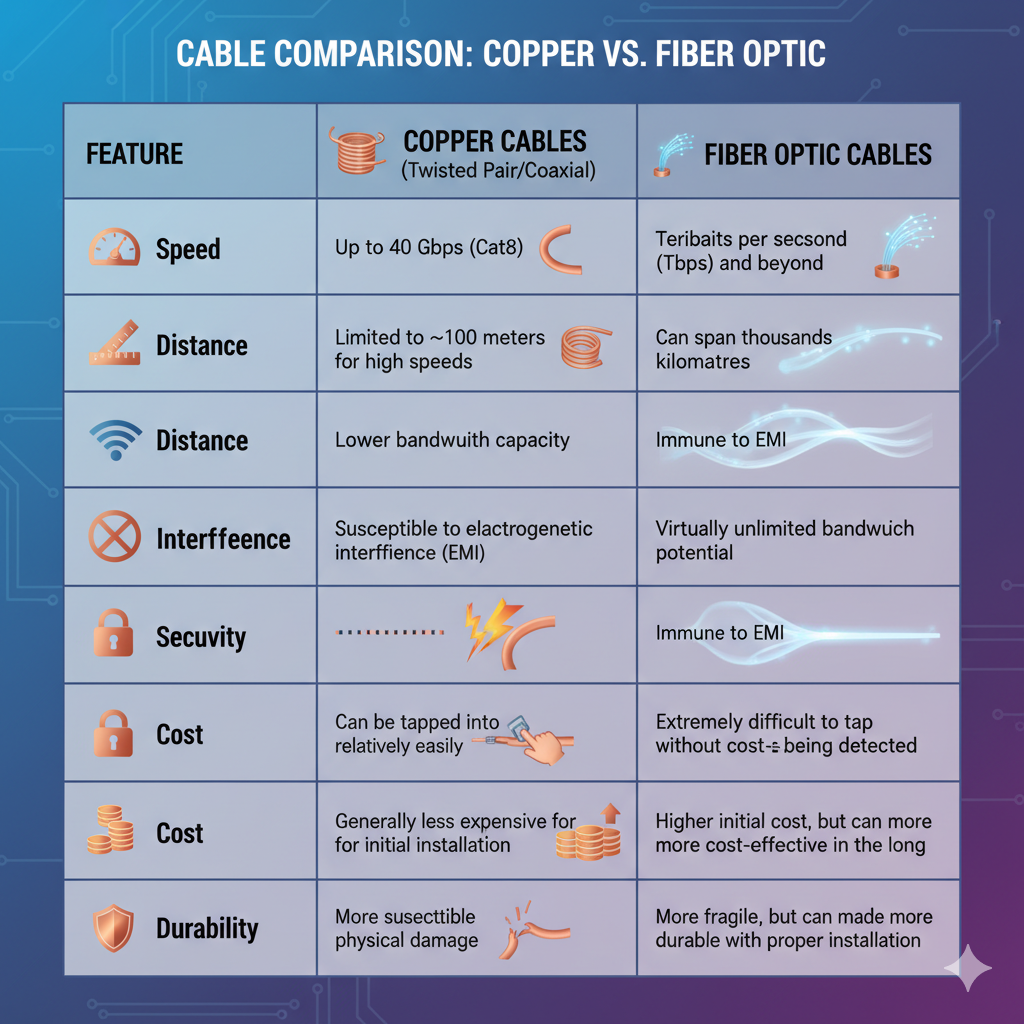
As you can see, fiber optics offer significant advantages in terms of speed, distance, and bandwidth.
However, copper cables are still a viable and cost-effective solution for many applications, especially in local networks where distances are short and the need for extreme bandwidth is not as critical.
The Future of Connectivity: What’s on the Horizon?
The quest for faster, more reliable, and more efficient data transmission is a never-ending journey.
As our reliance on data-intensive applications like artificial intelligence, virtual reality, and the Internet of Things (IoT) continues to grow, so too will the demands on our network infrastructure.
Here are some of the exciting developments we can expect to see in the coming years:
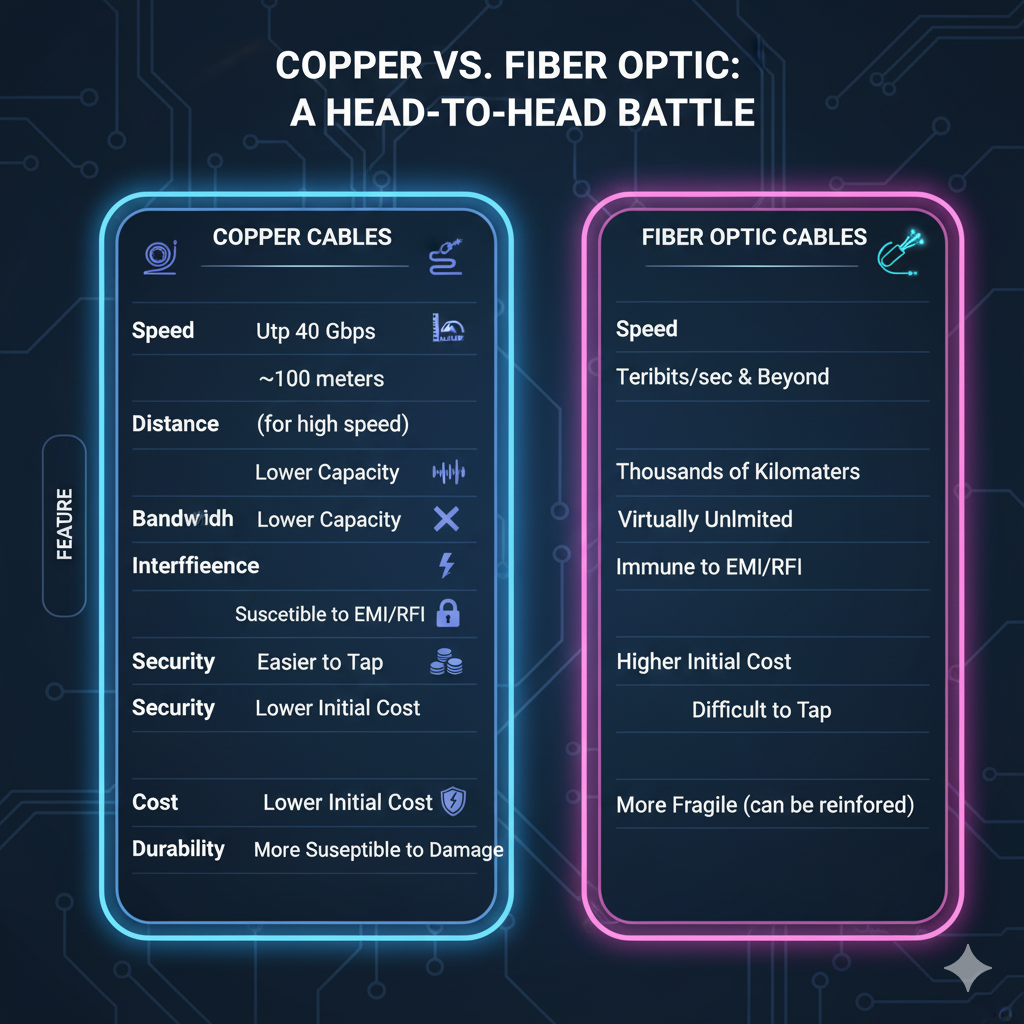
Advancements in Fiber Optics
Fiber optic technology is far from reaching its full potential.
Researchers are constantly pushing the boundaries of what’s possible, with recent breakthroughs achieving data rates in the hundreds of terabits per second.
We can expect to see the development of new types of fiber, such as hollow-core fiber, which has the potential to transmit data at even faster speeds with lower latency.
Additionally, advancements in optical switching and amplification will enable more efficient and flexible optical networks.
The Rise of Terahertz and Quantum Networking
Looking even further into the future, we may see the emergence of entirely new networking paradigms.
Terahertz (THz) communication, which operates at frequencies much higher than current wireless technologies, could offer unprecedented data rates over short distances.
Quantum networking, which leverages the principles of quantum mechanics to transmit information, promises unhackable communication and the ability to connect quantum computers into a powerful quantum internet.
The Role of Software-Defined Networking (SDN)
While hardware advancements are crucial, software will also play a key role in shaping the future of networking.
Software-Defined Networking (SDN) is a new approach to network management that decouples the control plane from the data plane.
This allows for more centralized and automated control of the network, making it more agile, flexible, and efficient.
SDN will be essential for managing the complex and dynamic networks of the future.

Li-Fi: Data Through Light
Li-Fi (Light Fidelity) is a wireless communication technology that uses visible light to transmit data.
It has the potential to offer much higher data rates than Wi-Fi, with the added benefit of being more secure and less susceptible to interference.
While still in its early stages of development, Li-Fi could one day become a common feature in our homes, offices, and public spaces.
Conclusion: A Connected Future
From the humble twisted pair to the cutting-edge of quantum networking, the evolution of network cables and data transmission technologies is a testament to human ingenuity.
As we’ve seen, each type of cable has its own unique set of characteristics, making it suitable for different applications.
While copper cables will continue to play an important role in our local networks, the future undoubtedly belongs to fiber optics and the even more advanced technologies that are on the horizon.
As we move towards a more connected and data-driven world, the importance of a robust and reliable network infrastructure cannot be overstated.
By understanding the technologies that underpin our digital lives, we can better appreciate the incredible complexity and innovation that makes it all possible.
The next time you stream a movie or video chat with a friend, take a moment to think about the invisible threads of connectivity that are making it all happen.
The future is bright, and it’s being transmitted through a network of light.
References
* [1] Tevelec. (2022, November 8). *What Are the 4 Types of Network Cables?*
* [2] Eaton. (n.d.). *Ethernet Cables Explained*.
* [3] Truecable. (n.d.). *Beginner’s Guide to Network Cables*.
* [4] NAI Group. (n.d.). *What Is Optical Fiber Technology, and How Does It Work?*
* [5] Smartech Cables. (2025, February 12). *Future of Networking Cables: Trends to Watch in 2025 & Beyond*.
* [6] AmeriFiber. (2025, September 29). *Latest Fiber Optic Technology 2025 for Faster Networks*.
* [7] IEEE Spectrum. (2024, July 8). *New Fiber Optics Tech Smashes Data Rate R
